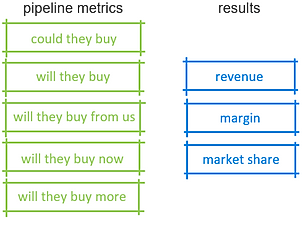“An unfortunate consequence of the adoption of CRM & sales force automation tools has been the confusing of measurement with management. What’s more, the data being used for measurement & analysis most often lacks truth.”
Your results are simply the outcomes of something that happened in the past. And you can’t manage the past. You can only manage the present.
The foundation for this article is based on a universal truth – your results are the outcomes of the decisions your customers make. Their decisions are the outcomes of your behaviours. Therefore, if you want to change your results, you have to change your behaviours.
I’m going to start at the end and work backwards – because it is likely you have been preconditioned to focus on the results. Results are lagging indicators, or measurements of what happened. Useful for keeping score, but by themselves offer no insight as to where or why we perform well (or not) and how we can improve. This would be like Steve Hansen (coach of the New Zealand All Blacks) picking up the paper on Monday morning and using the score to make decisions and recommendations for what changes or performance improvements are needed.
Enter the saviour – crm/sfa processes and tools. And this is where organisations become miss-aligned. In most cases, organisations implement CRM/SFA tools and processes with an internal or inside-out view. That is, using an internally defined set of criteria (sometimes with the help of external consulting & training companies) to measure where a customer is positioned relative to “our” sales process.

Notice the words: our “sales” process. Remember the universal truth? Results are the outcomes of your customer’s behaviours – that is the decisions they make as they move through “their” buying process.At this point, some of you will say “but we do use evidence of where the customer is in their buying process”. Here’s the rub – “budget has been approved”, “Identifying a critical business issue”, only means they might buy. It doesn’t mean they will, and it doesn’t mean they will buy from you or that they will buy now. When organisations use weak evidence and criteria, they end up with a pipeline of hope – there is little to no integrity in the opportunity pipeline.
The symptoms of an unhealthy pipeline are easy to spot – inaccurate forecasting, deals slipping or not closing when expected or deals being further discounted to bring them in on time. Worse still, sales management & leadership using alternative tools – like their own spreadsheet – for calculating their forecasts and commitments. What’s more, “weighted pipeline”, or probability percentages add further miss direction. It is probably a good thing that very, very few companies even bother to re-calibrate the probability gates based on actual results!
Transformation Step 1: Truth.
The first step for any organisation is to establish truth – good, bad or indifferent, meaningful change cannot start without it. Organisations must have very clear definitions, including customer-driven evidence, of where the customer is in their buying process as it relates to your company or solution offering. This doesn’t mean bringing in “best practice” of what others are doing. Go out and talk with both potential & existing customers and really find out how & why do they behave through their buying process. This effort can often be rewarded with uncovering how & where you can create competitive differentiation.

“Quantified (in financial terms) value (versus an alternative) of responding to a market change” (for example), is a significantly stronger indicator of the probability a customer will make a buying decision, sooner than “Identified a critical business issue”. When we introduce customer truths and drive Sales Manager discipline in inspecting the evidence (inspect what you expect), you bring integrity into the pipeline. With integrity, forecasting becomes more reliable and more predictable. Now organisations can introduce legitimate weighted averages for pipeline conversion.
However, this is only improving the ability to predict the outcomes of our current behaviour. Yep, back to our universal truth…..
“If you want to change your results, you have to change your behaviour”
Transformation Step 2: Changing Behaviour.
The effort of uncovering insights to your customer behaviour serves a second critical function to establishing pipeline integrity. Customer insight uncovers where, how & why customers are influenced and how they respond at each stage of their buying process – that is, organisations can now establish not just which sales behaviours have the most positive impact on the customer, but the proficiency of behaviour required to get them to a decision to buy, buy from you & buy now.

With a clear definition of the required and then demonstrated sales behaviour, corresponding evidence of customer response to measure the proficiency of execution, organisations can now start to address the heart of what is holding back their efforts for performance improvement.
By capturing empirical data on the proficiency of field execution (using tools such as f.a.c.t.) organisations can correlate behaviour (leading indicators) to outcomes (leaning indicators) to results (lagging indicators). More importantly, sales managers can spend far less time on on data analytics (measuring outcomes) and start coaching the right behaviours to the required proficiency (coaching inputs).
When organisations can correlate behaviour inputs to outcomes & results with truth & integrity, real meaningful change is inevitable. The change isn’t just in results. Organisations gain clarity across all aspects of the business. For example, HR/learning & Development, obtain very clear understanding of what competencies need to be hired to and/or developed. Marketing get clear on what messaging is required where & when and develop the sales collateral sellers really need.
There is a profound shift on offer here. Organisations can remove the stress of hoping for the right results, move beyond the misdirected comfort of probabilistic results, to a state of clarity and confidence in knowing you are doing the right things well – that is determining your future.
mike matthews – founder – Twisted Thinking Pte. Ltd.